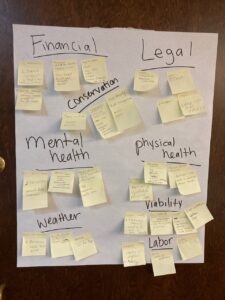Applied Research: Exploring the Best Ways to Alleviate Farm Stress
In order for SAgE—and the other three Farm and Ranch Stress Assistance Network regions—to effectively address farm stress, research is essential to discover the best methods to tackle it. Dr. Andy Smolski, SAgE’s Director of Applied Research, explains why applied research in particular is the type of research that’s needed to find solutions that can be put to work right away:

Dr. Andy Smolski, Director of Applied Research
There’s a distinction between what would be called basic research and applied research. We are not doing basic research: we are not trying to figure out generally how social systems operate or whether some fundamental or particular part is generalizable to a whole system.
What we are asking are applied questions about a very specific population or populations— farmers, ranchers, and farm workers—and then segmenting those populations even further, to ask things like, does social support provide some kind of benefit for farmers in terms of how they navigate farm stress and in terms of the outcomes? This is not to disparage basic research at all, but we want to convert our professional knowledge from these disciplines into usable tools that practitioners, extension workers, and farmers can can utilize for their own benefit.
The top-level work of FRSAN and its regional divisions is the delivery of resources and training to alleviate stress. The functional pieces of the work—the website, the hotline, the resource directory, partnership building, and applied research—are in support of that larger goal.
So a research question about the hotline in this context would not be a theoretical question about how hotlines function in a given social system. Rather, Smolski says, “the question would be whether access to a regional hotline translates to an increased perception of efficacy on the part of farmers, ranchers, farm workers, or even farm service providers to support one another.”
Smolski’s own academic lens that he brings to the research is that of a rural sociologist who looks at things in terms of “frames” that people use to interpret their reality. “It’s a way to look at the way people talk about or think about things to create meaning about the world they exist in, and then how that drives their actions,” he says. “And so we're very interested in the way that farmers with different lived experiences frame their circumstances in very distinct ways and how that impacts the strategies that they will use.”
Applied Research Projects
![]() Several of the current SAgE subaward funded projects are specifically applied research projects—from culturally grounded farmer interviews to participatory research to a handful of GIS projects (geographic information systems, which allow researchers and other practitioners to visualize, analyze, and interpret geographic datasets).
Several of the current SAgE subaward funded projects are specifically applied research projects—from culturally grounded farmer interviews to participatory research to a handful of GIS projects (geographic information systems, which allow researchers and other practitioners to visualize, analyze, and interpret geographic datasets).
The culmination of these projects will be a research deliverable: a SAgE research brief that will be made publicly available, a webinar, or a dataset that can be used by other researchers to continue looking at the questions and adding to the body of research generated. For the GIS projects, the datasets generated will be plotted onto a searchable map. The interviews, participatory research, and mapping projects all contribute to the collection of resources and development of training at the heart of SAgE's work.
A recent workshop with Operation Spring Plant, a Black farmer-led community organization in North Carolina that benefits minority and limited-resource farmers, was applied research in action. A group of 18 farmers was recruited out of more than 100 Operation Spring Plant conference attendees to engage in asset mapping and appreciative inquiry, which Smolski defines as “an affirmative and participatory research process to understand the strengths and assets a communtity has as its disposal and develop a shared vision of the future.”
organization in North Carolina that benefits minority and limited-resource farmers, was applied research in action. A group of 18 farmers was recruited out of more than 100 Operation Spring Plant conference attendees to engage in asset mapping and appreciative inquiry, which Smolski defines as “an affirmative and participatory research process to understand the strengths and assets a communtity has as its disposal and develop a shared vision of the future.”
For three hours, Dr. Smolski, Dr. Kathy Royal of Operation Spring Plant, and graduate assistant Elisabeth Ramsey worked with the farmers on sharing their stories, building themes, and mapping resources that they rely upon to operate. Because the group was made up of Black farmers, the Black farmer experience informed the conversation and selection of resources.
This demonstrates not only SAgE’s community-grounded approach to being a resource clearinghouse, but also a commitment to applied research that centers farmers and their lived experience. That way, Smolski says, research questions don’t always start with the researchers, but may originate from the farmers who will ultimately benefit from the research and its findings.
